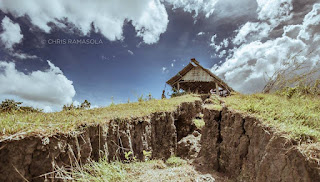One could not be blamed for
imagining that, amid all the world’s advancements in science, volcanology would
have figured out a way to foresee when earthquakes happen with as ample an
amount of time as we now have before hurricanes and typhoons come to us, given
how ubiquitous these tremors are in the ring of fire that is home to Japan, one
of the world’s forerunners in scientific innovation and research. Alas, it has
not. And, unfortunately for Boholanos, nobody could have seen the quake
coming ten years ago.
The 13th of October
2013 should have been an uneventful day for most people living in Bohol. Plotted
on the national calendar as a legal holiday, it was one that was meant to be
celebrated by different groups of people for different reasons. Foremost, for
the Muslim community, it was to be the year’s largest and most important holiday
– the Eid al-Adha, the Feast of the Sacrifice, a day of celebration in
remembrance of the obedient devotion of Abraham to God. For the rest of us, it
meant either no school for students, no work for government staff, or a nice
day at the workplace for private sector employees knowing they were getting
double the amount of a day’s standard wages. Whatever you believed in, it was a
day to look forward to.
As fate had it, however, what was
supposed to be a welcome day for all was flipped into utter chaos. Just a few dreadful
seconds and it all came crashing down – literally – into what would forever be
etched into the collective memory of Boholanos as one of the island province’s most
harrowing days. For nearly half a minute, it felt as though a primordial entity
living underground was clamoring for a way out. To say the Earth shook would be
a dire understatement. It was felt for miles all over the archipelago, but here
where it happened, it was a horror film come to life. Buildings crumbled to
pieces, bridges fell into rivers, the ground cracked open, and centuries-old edifices
that have come to define Boholano cultural heritage were reduced to nothing but
sad agglomerations of cubed limestone and coral dust within a few blinks of an
eye.
It was a strange and unfamiliar catastrophe
– one that no living Boholano had ever experienced on the island, especially
not its then chief executive, Edgar Chatto. First-hand sources claim that without
wasting a second, at the end of the main tremor, the governor rushed to kickstart
emergency response and damage assessment at the command center of TaRSIER 117. The
latter unit, named after Bohol’s most prominent primates, was barely in its
infancy stage at this point, but along with everything that the provincial
government could muster, it had to be put to work in what was described by staff
members as nothing short of a baptism by fire.
That very same morning, the
governor gave no second thought to pulling key people out of their lawful day
off to form a team that created and consequently activated a comprehensive
response plan, mobilizing every available resource to ensure people’s basic
needs were met. By nightfall, the team had been able to pool volunteers for
needs relief operations. The Bohol Cultural Centre, with its wall cracks and
fallen ceiling boards, was transformed into a hub where food was packed before
being darted off into the homes of those that needed them, especially in the
areas that were now made inaccessible by the destruction of infrastructure.
Such was the scene that prevailed for days and days, while the nitty-gritty of rehabilitation
work proceeded backstage, so to speak.
Edgar Chatto, at this point, had just begun his second term as governor after emerging victorious from what could be described as one of Bohol’s most vicious gubernatorial races. He was no stranger to hard work. In fact, his personal slogan leading up to his very first term a few years prior was “to hit the ground running.” However, it was ultimately his choice to toil tirelessly. In the latter case, he did not have a choice. Nobody did. This was a true test to his capabilities and he made sure that all options were explored, all helping hands tapped, and all friends given a ring. Not least of which was the president himself, Benigno Aquino III, who discreetly flew into the province bringing help and much-needed supplies, and it was perhaps the first time in our republic’s rich history that the head of state was billeted to spend the night in a lowly tent despite being in one of the country’s most prominent tourist destinations. But neither the president nor the governor cared about quality of accommodation nearly as much as they did about the well-being of the Boholano people. This was a challenge to the leadership of the president as much as it was to the governor and any other leader who cared.
Leaders – the true ones – are a
special kind of people, in my view. Always ready, never tired. Facing
challenges head-on and dragging inspiring others around them to step up.
It is a special kind of talent – a kind of superpower, if you will – that not
everyone possesses and to this day I am not convinced that it is something that
can be learned from scratch. I’m not sure if true leaders are born or made or
either or both. Because while many of them put themselves out there to be
called upon by those they serve, there are others who emerge only when they are
truly needed. As if summoned by a divine force, several such leaders manifested
themselves during the earthquake’s aftermath in the fashion of a collective
of comic book superbeings who had come in a moment of dire need to face a very
powerful common adversary. Everyone was there for us and with us – local and
national government agencies, international organizations, foreign governmental
cooperation agencies, non-government groups, the military, law enforcement, the
scouts, the private sector, civil society, as well as faith communities
including but not limited to the leadership of the Catholic Church.
For the most part, people crossed
party lines, put aside their personal and political differences, and momentarily
suspended their hostilities as they worked toward their common goals – first
survival then sustainable rehabilitation. In school, Filipiniana and
values education teaches us about the spirit of Bayanihan, illustrated
by a village lifting a hut presumably belonging to people who wish to move
somewhere. I had seen this at work many times, but only ever on small scales, like
how the concept was introduced in school. So, for a long time I wondered if
this could happen on a large scale. The earthquake of 2013 answered this
question in one of the most inspiring ways possible. No act of service was too
small for a person with a sincere heart and no challenge was too big a leader.
Ten years on and this is where we
are today, thanks to the team effort of the people of Bohol and our leaders, big-time
or small-time, known or unknown, who played a role in the long and grueling process
of healing and rebuilding, starting with the spirits that had been broken. Now,
our roads have been repaved; our bridges have been rebuilt; and our
centuries-old heritage churches and cultural treasures have risen again as
though they never fell. Tourism has bounced back time and time again following
a multitude of challenges and our local economy is doing fairly well considering
the kind of battery it has been subjected to over the years since then.
Quite a few more harrowing
episodes have followed since the 2013 earthquake and we as a people have proven
over and over that not only are we resilient, we are also a very strong and capable
lot, full of leaders who are ready to step up to the challenges hurled at us.
The tremor might not have been the worst thing to happen thus far but it was
certainly a strong wake-up call and it allowed us to learn to gird our loins,
armor up and hone our skills to be able to face every single one that comes our
way, supporting and learning from one another and emerging as better people and
better leaders each time. As Edgar Chatto always says, “Leadership is a gift
from God for man to develop and share with others.”















